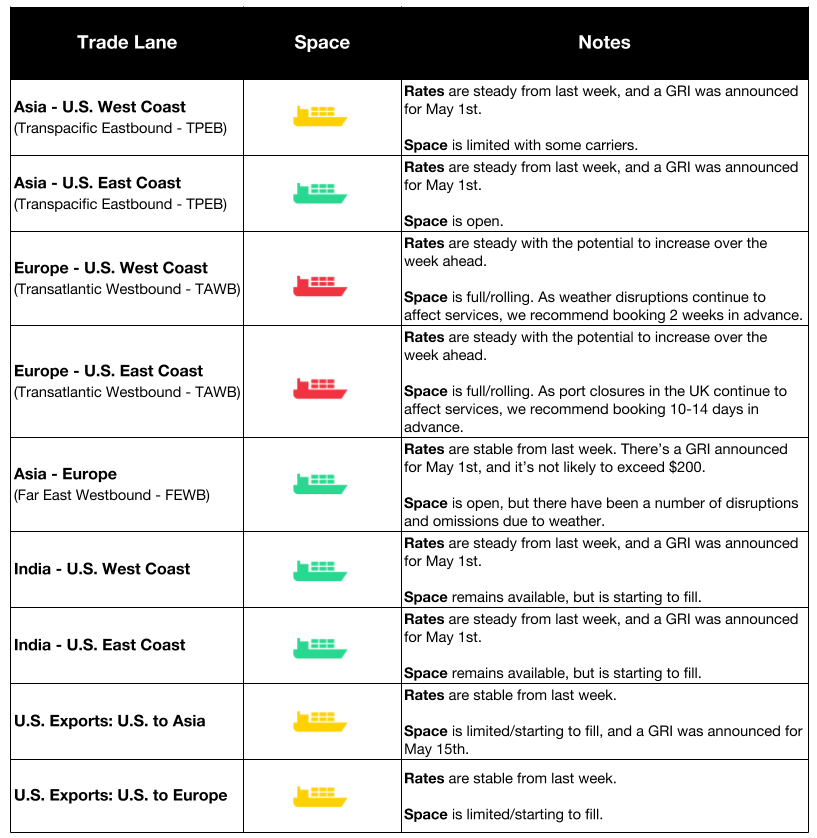Market Update
Market Update: April 25, 2018
Ocean, air, and trucking freight rates and trends for the week of April 25, 2018.
Market Update: April 25, 2018
Want to receive our weekly Market Update via email? Subscribe here!
Ocean Freight Market Updates

GRI Announcements for May 1st & 15th
A General Rate Increase (GRI) has been announced for the following lanes and dates:
- Transpacific Eastbound (TPEB): May 1st
- Far East Westbound (FEWB): May 1st
- India-US: May 1st
- US Exports: May 15th
India - U.S. East Coast: New Service in June
Pacific South Loop (PS3), the first direct service from Northern India to the USWC, will begin in June.
Air Freight Market Updates

Ex-U.S. Rates Expected to Increase
Select carriers (both passenger and cargo-only) have indicated that rates will increase slightly over the coming months. This is despite the fact that there is typically increased capacity heading into summer months due to additional seasonal flights for holiday travelers.
Ex-Vietnam Demand Expected to Increase
Export demand is expected to increase following these upcoming public Vietnam holidays:
- April 30th: Reunification Day
- May 1st: May Day
Air Freight Demand Increases With E-Commerce Trend
According to a recent UPS study, online shoppers are increasingly looking to international vendors when shopping. The e-commerce trend places pressure on air freight, as shoppers look for fast delivery times. The increase in demand could lead to rate increases and capacity shortages.
Trucking Market Updates
High Freight Costs Affect Earnings at Big Consumer-Goods Companies
The Coca-Cola Co. North American division reported that freight costs were up 20% from a year ago in the first quarter. This mirrors what manufacturers and retailers across the nation are seeing, as increased transportation costs affect first-quarter earnings.
Why is capacity tightening? Many attribute the limited space to bad weather, high turnover among truck drivers, and the ELD mandate. “It’s really coming from the trucking industry and…the new electronic logging-device rules and driver shortages,” says Hasbro Chief Financial Officer Deborah Thomas.
As shippers compete for a limited amount of trucking capacity, many expect the issue to persist through 2018.
The Electronic Logging Device (ELD) Mandate: What You Need to Know
U.S. Spot Market Truck Volumes on the Rise
As spring retail and produce demand increase, so too do the U.S. spot truck rates. After the minor dip in rates in February, the trucking industry is again feeling the pressure on capacity and rates.
This news aligns with the record-breaking pace of big rig orders placed by trucking companies in the first quarter. According to The Wall Street Journal, “The gap between demand and capacity has led truckers to charge higher prices, giving fleet owners more cash to replace older vehicles and greater confidence in future demand.”
LA-LB Terminals Agree to Restructure PierPass Program
Agreeing to restructure the 13-year-old PierPass program, Los Angeles-Long Beach marine terminal operators will reduce the traffic mitigation fee to $31.52 per TEU, a 55% reduction.
Assuming the Federal Maritime Commission approves the restructuring, the new pricing will take effect in August 2018.
